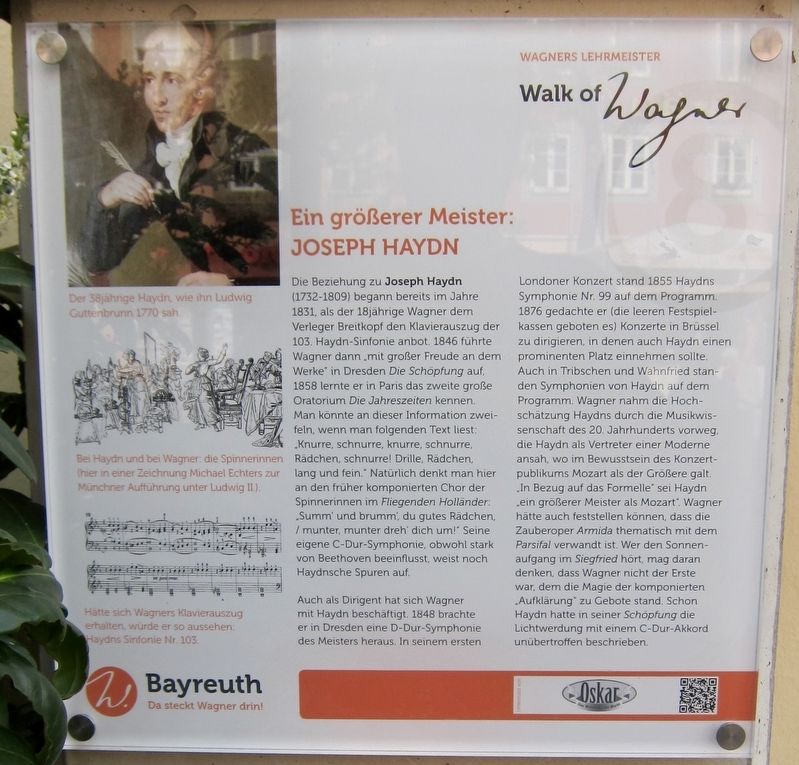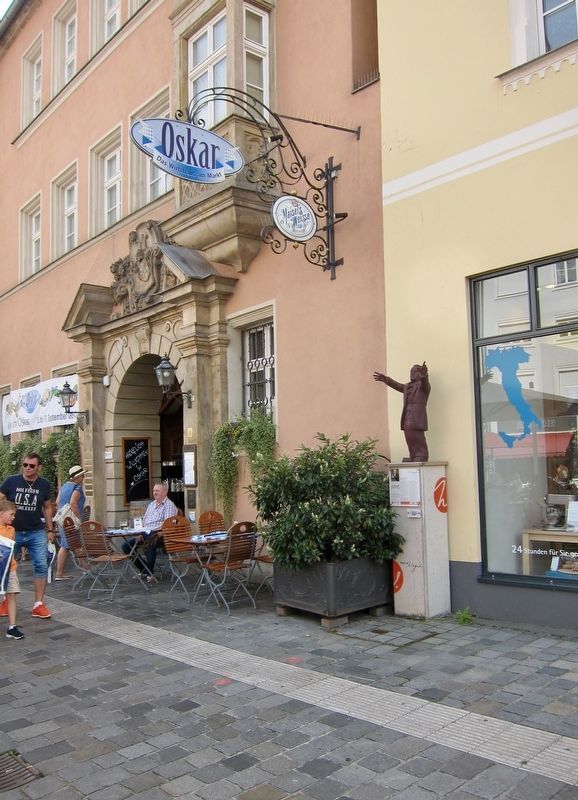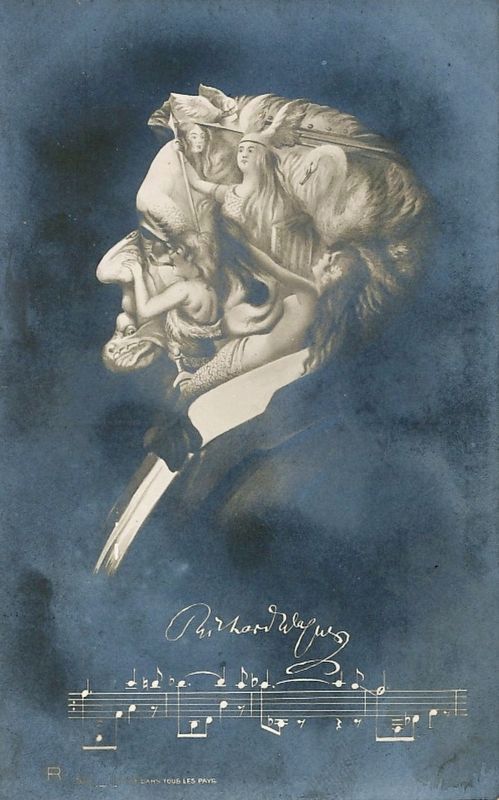Ein grösserer Meister: Joseph Haydn / A Greater Master: Joseph Haydn
Walk of Wagner
Auch als Dirigent hat sich Wagner mit Haydn beschäftigt. 1848 brachte er in Dresden eine D-Dur-Symphonie des Meisters heraus. In seinem ersten Londoner Konzert stand 1855 Haydns Symphonie Nr. 99 auf dem Programm. 1876 gedachte er (die leeren Festspielkassen geboten es) Konzerte in Brüssel zu dirigieren, in denen auch Haydn einen prominenten Platz
einnehmen sollte. Auch in Tribschen und Wahnfried standen Symphonien von Haydn auf dem Programm. Wagner nahm die Hochschätzung Haydns durch die Musikwissenschaft des 20. Jahrhunderts vorweg, die Haydn als Vertreter einer Moderne ansah, wo im Bewusstsein des Konzertpublikums Mozart als der Größere galt. „In Bezug auf das Formelle" sei Haydn „ein größerer Meister als Mozart". Wagner hätte auch feststellen können, dass die Zauberoper Armida thematisch mit dem Parsifal verwandt ist. Wer den Sonnenaufgang im Siegfried hört, mag daran denken, dass Wagner nicht der Erste war, dem die Magie der komponierten „Aufklärung" zu Gebote stand. Schon Haydn hatte in seiner Schöpfung die Lichtwerdung mit einem C-Dur-Akkord unübertroffen beschrieben.
Richard Wagner's relationship with Joseph Haydn (1732-1809) began in 1831, when the 18-year-old Wagner offered the piano score of Haydn's 103rd Symphony to the musical publisher, Breitkopf. In Dresden in 1846, Wagner performed The Creation "with great joy", and in Paris in 1858 he became familiar with the second great oratorio, The Seasons. One might doubt this information if one were to read the following text: "Growl and hum, growl and hum, Spinning Wheel, hum! Spin, wheel, long and fine!" Of course, one is reminded here of the earlier-composed choir of Fates
As a conductor, Wagner also had Haydn's works performed. In Dresden in 1848 he brought out the master's D Major Symphony. In his London concert debut in 1855, Haydn's Symphony No. 99 was on the program. In 1876 he (the empty festival cash registers commanded it) directed concerts in Brussels, giving Haydn prominence. And in Tribschen and Wahnfried symphonies by Haydn were also on the program. Wagner anticipated Haydn's esteem for the musicology of the twentieth century, which Haydn regarded as the representative of a modern age, where in the consciousness of the concert audience Mozart was considered the greater. "In terms of the formal" Haydn was "a greater master than Mozart". Wagner would also have noticed that the magical opera Armida is related thematically to Parsifal. Whoever hears the sunrise in Siegfried may remember that Wagner was not the first to master the magic of the "enlightenment" in composition. Haydn had already, in a manner unsurpassed, described the Beginning of Light with a C Major chord in The Creation.
Erected 2014 by Bayreuth Marketing & Tourismus GmbH.
Topics. This historical marker is listed
Location. 49° 56.657′ N, 11° 34.491′ E. Marker is in Bayreuth, Bayern (Bavaria). Marker is on Maximilianstrasse, on the right when traveling east. Touch for map. Marker is at or near this postal address: Maximilianstrasse 33, Bayreuth BY 95444, Germany. Touch for directions.
Other nearby markers. At least 5 other markers are within walking distance of this marker. Max Stirner (a few steps from this marker); E.T.A. Hoffman: Ein genialer Dichter und grosser Musiker / A Genius Poet and Great Musician (about 180 meters away, measured in a direct line); Spitalkirche / "Spital" Church (about 210 meters away); Stille Wasser gründen tief... / Still Waters Run Deep (approx. 0.2 kilometers away); Dr. Jakob Herz (approx. 0.4 kilometers away).
More about this marker. This is one of sixteen markers installed throughout Bayreuth to mark the 200th anniversary of the birth of composer Richard Wagner, each detailing some facet or influence in Wagner's life.
Also see . . . Richard Wagner (Wikipedia). "Wilhelm Richard Wagner (22 May 1813 – 13 February 1883) was a German composer, theatre director, polemicist,
and conductor who is primarily known for his operas (or, as some of his later works were later known, "music dramas"). Unlike most opera composers, Wagner wrote both the libretto and the music for each of his stage works. Initially establishing his reputation as a composer of works in the romantic vein of Weber and Meyerbeer, Wagner revolutionised opera through his concept of the Gesamtkunstwerk ("total work of art"), by which he sought to synthesise the poetic, visual, musical and dramatic arts, with music subsidiary to drama. He described this vision in a series of essays published between 1849 and 1852. Wagner realised these ideas most fully in the first half of the four-opera cycle Der Ring des Nibelungen (The Ring of the Nibelung)." (Submitted on January 4, 2018.)
Credits. This page was last revised on January 28, 2022. It was originally submitted on January 4, 2018, by Andrew Ruppenstein of Lamorinda, California. This page has been viewed 202 times since then and 15 times this year. Photos: 1, 2. submitted on January 4, 2018, by Andrew Ruppenstein of Lamorinda, California. 3. submitted on January 4, 2018.


